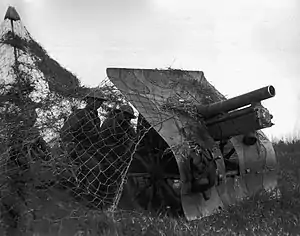Bofors 75 mm mountain gun
The Bofors 75 mm mountain gun was a German-designed and Swedish-built mountain gun of the interwar years that was used during the Second World War.
| Bofors 75 mm mountain gun | |
|---|---|
 A Bofors 75 mm gun in Chinese service | |
| Type | Mountain gun |
| Place of origin | Sweden |
| Service history | |
| Used by | See users |
| Wars | World War II |
| Production history | |
| Designer | Krupp |
| Designed | 1919-1920 |
| Manufacturer | Bofors |
| Produced | 1923 onwards |
| Variants | L/20 L/22[1] |
| Specifications | |
| Mass | Combat: 790 kg (1,740 lb) Travel: 1,000 kg (2,200 lb) |
| Barrel length | 1.5 m (4 ft 11 in) L/20 1.6 m (5 ft 3 in) L/22 |
| Width | .95 m (3 ft 1 in) |
| Crew | 4[1] |
| Shell | Fixed QF 75 x 212mm R Fixed QF 75 x 241mm R[2] |
| Shell weight | 6.5 kg (14 lb 5 oz) |
| Caliber | 75 mm (3 in) |
| Breech | Horizontal sliding-wedge |
| Recoil | Hydro-pneumatic |
| Carriage | 2-wheeled box trail |
| Elevation | -10° to +50° |
| Traverse | 6°[1] |
| Rate of fire | 25 rpm |
| Muzzle velocity | 470 m/s (1,500 ft/s) |
| Maximum firing range | 10.5 km (6.5 mi)[1] |
History
In 1919–1920 Krupp designed a new 7.5-cm L20 mountain gun, but the Treaty of Versailles and German disarmament banned manufacturing guns under 170 mm in calibre at the company, so it licensed the product to Bofors[3] (also, since 1920 Krupp held 31.8% of Bofors stock through its Swedish subsidiary AB Boforsintressenter despite a 1916 law prohibiting foreigners from having over 20% stock of a Swedish business[4]). Under an 1921 agreement the company agreed not to export any Krupp-derived materiel to the victors of WWI: the UK, US, France, Italy and Japan.[5]
Bofors, which had never build mountain guns before, had to set up a saddler's workshop which worked until 1980s, and buy donkeys and mules to carry the pack guns. After a Swedish-made prototype passed field tests in Java, KNIL became the first customer in 1923, ordering 30 guns with ammunition and other auxilliary equipment; orders from Turkey and other countries followed starting from 1928.[6]
Design
The Bofors 75 mm mountain gun was built in two main versions, one had a barrel of 20 calibers in length and the other a barrel of 22 calibers in length. Both had a two-wheeled single-axle box-trail carriage with shield, which could be towed by a horse team or broken down into eight mule loads for transportation. In addition to its use by Sweden it was widely exported.[1]
Users
Photo gallery
 Brazilian army museum in Copacabana.
Brazilian army museum in Copacabana. Bofors 75mm mountain gun M1930
Bofors 75mm mountain gun M1930
Notes
- Foss, Christopher (1977). Jane's pocket book of towed artillery. New York: Collier. p. 31. ISBN 0020806000. OCLC 911907988.
- "75–77 mm Calibre Catridges". www.quarryhs.co.uk. Archived from the original on 2015-01-17. Retrieved 2017-09-13.
- Trials of War Criminals Before the Nuremberg Military Tribunals Under Control Council Law No. 10, Nuernberg, October 1946-April 1949. U.S. Government Printing Office. 1950. p. 273.
- Lorenz-Meyer, Martin (2007). Safehaven: The Allied Pursuit of Nazi Assets Abroad. University of Missouri Press. ISBN 978-0-8262-6586-9.
- German Yearbook on Business History 1982 p=131.
- "Artillery pieces and combat vehicles | Stories | Saab".
Bibliography
- Christopher Foss: Jane's Pocket Book of Towed Artillery. New York. Collier Books. 1977. ISBN 0354010867
External links
- http://www.quarryhs.co.uk/ammotable8.html Archived 2015-01-17 at the Wayback Machine